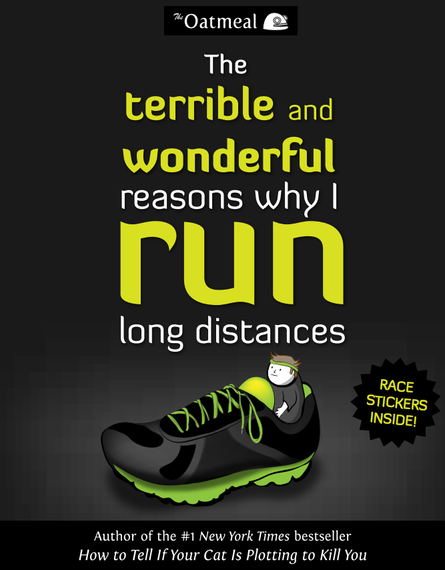It must have been 10 years ago, maybe 12, but that sodden run with a group of middle-aged women, all of us eager to stay fit, stays with me. Together, we ran up and down a steep suburban road -- hill repeats, in running parlance -- while the sky unloaded on us and the temperature dropped. Drivers honked and stared, incredulous that we would choose to be out here in a storm, running hills no less, for no apparent reason. When we finished, we all took off for home, exhilarated (and maybe a little hypothermic) from our battle against gravity and nature.
Non-runners don't get it, but Matthew Inman, aka "The Oatmeal," does. In The Terrible and Wonderful Reasons Why I Run Long Distances, Inman explores what makes this activity so strangely compelling. Inman is a Seattle-based cartoonist with a robust fan base, and his graphic memoir/how-to guide to running offers readers a take on the sport that's both sophomoric and profound. It's the ideal book for high school runners and other newbies to the sport who might need some nudging every now and again to keep at it.
Inman started running as a young adult, when he grew weary of living behind a computer screen. Over time, he found that running helped him battle his appetites, particularly his desire to eat bad food, and a lot of it. What he calls the "blerch" -- the foul offspring, apparently, of belch, retch, and blubber -- is his internal nemesis, a winged, marshmallow-like creature who hovers over his shoulder and advises Inman to take it easy, skip the run, and have a Pop-Tart. The blerch is his former self, a fat kid lacking discipline, who still torments the author and tries to hijack his grown-up good intentions. "I run because I'm terrified of becoming that kid again," Inman writes. "I run because it's the only way I know how to quiet the monster." He finally declares a ceasefire with the blerch, embracing that part of himself while doing his best to keep the little beast under control.
His message, that suffering through running brings contentment, if not joy, will be familiar to readers of Haruki Murakami (the Japanese marathoner and author of What I Talk About When I Talk About Running), whom he cites, and George Sheehan, the late poet/philosopher from Runner's World magazine. What makes the message fresh is his irreverent graphics, which express his alternating self-loathing and pride better than words alone. His cartoon alter-ego jogs with a taco and bottle of dressing strapped to his belt, pouring Skittles and chocolate down his gigantic gullet. His new running body is a mix of emaciated torso, spindly arms and freakishly huge legs dotted with spider veins, an improvement over his lumpy self but not the macho fantasy man he had imagined he would become. After surviving a torturous run through heat, hornets, and storms, and then uncovering the meaning of existence -- "forget the why" and experience the here and now, in all its majesty and sorrow -- his giddy doppelganger glides across the sky on a bottle of purple soda, ready to embrace the evening stars.
In offering strategies for how to stick with it, he provides advice that's familiar to anyone who has ever struggled to maintain athletic or dietary discipline; "shut up and run" is a ruder variation of Nike's spot-on campaign to "just do it." But Inman doesn't minimize the suffering that serious running causes, reminding readers that "running sucks in the beginning" and advising us to face the pain inherent in the sport. Even so, he skips one of the most effective ways to compel yourself out the door: make a date. Having a commitment to meet someone else can force the laziest of us to get moving, and can lead to unexpectedly rich relationships.
It's odd that Inman rarely addresses running with others, because this is one of the sport's most appealing rewards. Running long distances with another is a short cut to friendship. Because what else is there to do, when you're out there for hours with another human being, but talk? About your needy kids, your ailing parents, your iffy knee, your impending emotional collapse, your emergency trip to the vet, what you're reading, what you heard on NPR, what's for dinner. It's all fair game. My longtime running partner might as well be my second husband; we know each other so well that we make a point of not sitting together at dinner parties.
But this is his book, chronicling the reasons he runs, and Inman derives mainly solitary benefits from the sport. (This is perhaps truer for males than females. How odd it is to run by two fellows going for a chatty run, and how routine to spot gangs of women doing just that.) I too enjoy a solitary run from time to time, using the time to write in my head, just as Inman uses his to draw.
Before heading out for a run years ago, my practical and stoic grandmother asked me, "do you have somewhere you have to go?" Not exactly, I thought, unable to articulate why running around the cornfields of Iowa made any sense. Now, Matthew Inman has done it for us. Though I don't think Grandma would have understood the blerch.
